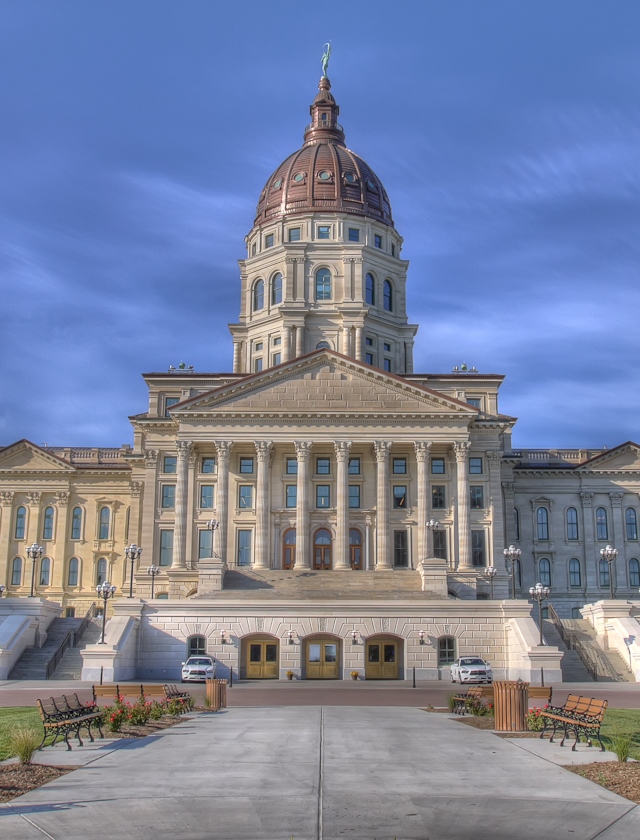(Updated to reflect lawmaker reaction to Kelly budget; will be updated again this afternoon.)
Gov. Laura Kelly’s new budget proposal came under immediate fire Thursday with Republican lawmakers questioning how she will pay for her spending plan by restructuring payments to the state’s retirement system.
Kelly’s proposal to reamortize payments to the Kansas Public Employees Retirement System over 30 years will save the state $145 million, which frees up money to pay for the programs the new governor wants to finance.
Currently, the state is on track to cover most of its unfunded liability by 2033. Under the governor’s plan, the unfunded liability wouldn’t be covered until 2050. Stretching out the payment period under the governor’s plan would cost about $7 billion in interest.
Budget Director Larry Campbell said there will be no cuts to service or retirement benefits for state retirees.
“Reamortization is a common tool for managing pension systems,” Campbell said. “The governor’s recommendation to reamortize at this time is prudent and worthy of your consideration.”
However, Senate Majority Leader Jim Denning raised questions about the reamortization plan, noting that’s a decision that’s been delegated to the retirement system’s board of trustees.
Denning said the system’s executive director has already indicated that the board is not interested in restructuring the payments until 2025 at the earliest.
“This whole budget is built on a house of cards,” Denning told reporters.
“In my wildest dreams I can’t imagine this Legislature forcing the KPERS board to reamortize and add $7 billion to the liability of KPERS,” he said. “I can’t see this Legislature going down a path of mortgaging the future of every single person that gets a KPERS retirement check.”
Administration officials said the reamortization plan stabilizes the state budget in the long term so that various agencies don’t have to keep forking out large sums of money for big jumps in retirement system payments.
They compared it to financing a house with an adjustable mortgage rate that suddenly spikes upward, forcing the homeowner to refinance with a fixed mortgage interest rate.
The governor’s budget plan, they said, now allows agencies to spend more on government services such as education and health care.
Treasurer Jake LaTurner, who serves on the board for the state’s retirement fund, called Kelly’s plan “irresponsible.”
“By taking an additional 15 years to fully fund the plan, the state loses the opportunity to invest over $160 million each year, costing Kansas potentially $7 billion in earnings,” said LaTurner, who is running for the U.S. Senate.
“We cannot keep kicking the can down the road and asking our children and grandchildren to foot the bill.”
Campbell on Thursday morning unveiled the governor’s first budget, which recommends spending money on Medicaid expansion, public education, child welfare workers and corrections officers, as well as pay raises for state employees.
The plan recommends $14 million to expand Medicaid coverage to about 150,000 Kansans, an equation Republican lawmakers are already questioning.
It also includes $92 million to go toward meeting a state Supreme Court order demanding the state add money to schools to cover the cost of inflation.
The last two years, the Legislature put more than $800 million into schools, which the court found wasn’t quite enough to adequately fund public education.
Kelly said Wednesday night that school funding is divided out from the rest of the budget to bring clarity to the issue.
The governor wants the Legislature to approve a school funding plan by Feb. 28 to give the attorney general time to comply with a court-ordered deadline. The Supreme Court has set April 15 as the deadline for the first round of briefs to be filed.
Kelly’s budget calls for spending $4 million to hire 55 additional child welfare workers to meet an increasing caseload that’s putting pressure on the state system.
It’s been reported that state child welfare workers are carrying more than twice the acceptable workload.
Child welfare workers are supposed to handle a maximum of about 15 abuse cases on average. Statewide, it’s 38, and in the Kansas City area, it’s 55.
While Kelly stressed the need for putting more money into roads during the campaign, the new governor’s budget recommends keeping $200 million of the $300 million that had been transferred from the highway department into the general fund.
The governor’s budget, however, seeks to end all of the transfers from the highway department to the general fund by fiscal year 2023.
Campbell said he thought sending $100 million back to the highway department was a “good, good start.”
“There were a lot of choices you could make,” Campbell said. “We basically wanted to balance every need and putting $100 million back in there was the choice we made.”
Asked why they didn’t put more back into transportation, Campbell said the administration wanted to keep a high ending balance. The governor’s budget leaves a nest egg of $686 million, the highest ending budget balance in 20 years.
During the last decade, more than $2 billion has been moved from the highway department to the general fund to cover other areas of the budget as the state faced shortfalls blamed on former Gov. Sam Brownback’s tax policy.
Other recommendations in the budget included:
- Adding $22.3 million for a 2.5 percent salary increase for state employees.
- Adding $3 million to hire more corrections officers.
- Restoring $9 million in higher education cuts from previous years.
- Putting $7 million into speeding up the processing of Medicaid applications at the KanCare clearinghouse.













